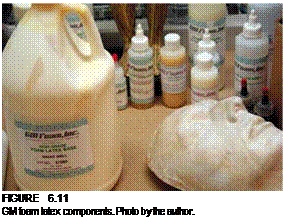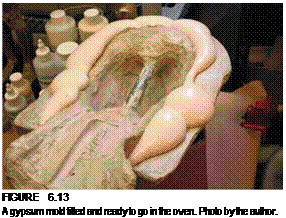I love foam latex! As a material for making prosthetic appliances for special makeup effects, foam latex is, in my opinion, unrivaled for performer comfort. Materials such as silicone might mimic the appearance and feel of human skin more believably and realistically, but silicone does not breathe, and an active actor wearing silicone appliances will begin to perspire rather profusely beneath the silicone if it is worn for an extended period of time, as many actors must. Gelatin will probably start to melt. Don’t get me wrong; the material for a given appliance should not be chosen randomly or by economy, and I have nothing against working with silicone or gelatin as an appliance material. I work with silicone quite a bit as well as gelatin and urethane (cold) foam. Appliance materials must be chosen based on numerous factors, such as climate, shot framing, performance, and budget. There are a number of foam latex systems on the market, and they are listed in the appendix at the back
of this book. I am most familiar with GM foam and have been using it for a number of years.

 I particularly love foam latex for its texture and feel. When it’s made well, it feels better than velvet, and every subtle expression and nuance of emotion is translated beautifully through the foam from the performer; it becomes the performer. A nearly full-face appliance will likely weigh less than an ounce and, when applied, is almost undetectable by the actor wearing it. Foam latex breathes, so it is comfortable and an actor can wear it all day long, as is frequently the case.
I particularly love foam latex for its texture and feel. When it’s made well, it feels better than velvet, and every subtle expression and nuance of emotion is translated beautifully through the foam from the performer; it becomes the performer. A nearly full-face appliance will likely weigh less than an ounce and, when applied, is almost undetectable by the actor wearing it. Foam latex breathes, so it is comfortable and an actor can wear it all day long, as is frequently the case.
Foam latex components (latex base, foaming agent, curing agent, gelling agent, color)

![]()
Misc. additives Timer
Digital scale Oven mitts Mold straps
quirks
However, though foam latex is extremely light, strong, breathable, and expressive, there are some qualities that could be construed as negatives by some. I must confess, to get that extremely light, strong, breathable, and expressive appliance, there are a number of hoops that must be jumped through to get there. Though every material
used to make prosthetics has quirks and idiosyncrasies, foam latex is probably the most difficult material to work with overall, from several perspectives.

First, foam latex is opaque. You can’t see through it. Unlike silicone and gelatin, which can be colored intrinsically to be semitransparent or translucent, just like real human skin, foam latex is naturally opaque. To create the semblance of translucency, the appliance must be painted with numerous transparent layers of pigment, usually with an airbrush, to achieve the look of real skin.
Second, foam latex requires a heat cure in an oven, and it cannot be the same oven you use to bake tollhouse cookies and Thanksgiving turkeys!
Why? Because third, foam latex gives off toxic fumes during the heat cure that will render your oven forever unfit for cooking. There are a few alternatives, one of which is building your own makeshift oven using infrared heat lamps in a well-insulated plywood box. I can show you how, if you’re interested. I am now using an old GE consumer oven that I rewired from 220v to 110v.
It’s not very large, but I can fit a two-piece mold for a full-face appliance and two smaller molds
in it pretty easily. I might be hard pressed to get a full bust mold for an over – the-head cowl in it, but it has served its purpose well, and I couldn’t pass up the price—free—when a neighbor remodeled his kitchen and asked me if I had any use for his old oven. (On the plus side, I get pretty terrific results with it.)
Whatever you use as your latex oven, your foam latex should cure in an oven that cannot exceed a controllable/maintainable 200°F. Ideally, foam should cure no hotter than 185°F (85°C). I frequently cook it at 170°F (about 77° C) for a longer time, as I will describe a little further on.
Foam latex is time and temperature sensitive. When I was first learning how to run foam, I remember mixing the foam according to the instructions for using GM Foam and watching the foam solidify in midpour from the mixing bowl into the mold. D’oh! It was like watching a cartoon.
Foam latex shrinks. The thicker the foam, the more it shrinks. That’s not to be confused with the volume of the foam; lower-volume foam (heavier) will shrink more than high-volume foam (lighter) because it has more air and a lesser proportion of foam latex components. It is water loss that causes shrinkage in the foam. Since higher – volume foam stretches more than denser low-volume foam, any shrinkage that does occur can usually be compensated by stretching, with little force exerted on the foam.
What the mold is made of also contributes to the shrinkage of the foam or the lack thereof. A porous mold like Ultracal will cause the foam to shrink less because it absorbs moisture from the foam.
Foam latex, being essentially a foam rubber sponge, will collapse into itself when it moves, such as with a fold of neck skin; silicone appliances displace
themselves remarkably like real tissue. These are tradeoffs that you must decide on during the design (and budgeting) phase of your makeup. Foam latex is more delicate than silicone and rarely survives removal in one piece at the end of the day, necessitating fresh appliances for each performance day the actor is in makeup. Silicone, if handled and treated carefully, can be robust enough even for delicate edges to survive multiple applications.
Before I describe the process for running a batch of foam latex, let me give you a little backstory on latex itself. Latex is a natural liquid that comes from the hevea tree grown in Malaysia, Thailand, Indonesia, the Philippines, and other tropical countries. The tree is tapped and a small amount of latex (only a few ounces) is collected from each tree before the cut on the tree congeals and heals itself. Each tree is tapped only once every two days. According to GM Foam’s technical information, over 95 percent of all natural latex is concentrated by a method called centrifuging. The result is a high-quality product containing 60-65 percent solids, used mainly for dipping compounds such as rubber gloves and condoms. The remaining latex, which is less than 5 percent of the world’s production, is concentrated by another method called creaming, a process whereby ammonium alginate is added to the raw latex, causing separation. The watery "serum layer" is drained from the vats, leaving a higher concentration of latex.

![]()
Ammonia is then added as a preservative; this also prevents the latex from coagulating, leaving the final concentration at approximately 68 percent latex solids. Creamed latex separates over time and will continue to separate unless it is shaken on a weekly basis, to keep it mixed and fresh. This type of latex has a greater stretchiness than the centrifuged latex, so it is also considered the best latex for making prosthetic foam.
Since latex is a natural product, its composition is dependent on environmental conditions. The hevea trees and the latex are affected by how much rainfall there is in a given season, how many sunny days, how young the trees are, and so on. Thus, the quality of rubber varies from season to season, year to year, and month to month. These fluctuations can wreak havoc for artists running foam for makeup effects, because the latex will behave differently all the time. What GM Foam does when it purchases creamed latex is to calibrate its own latex base. When the company receives the latex, it first adjusts the pH balance, then conditions the latex with additives and finally makes a special blend with other types of latex. By doing this GM Foam can carefully control the cell size, foam volume, flow, and gel time. This means that if you follow the instructions provided with GM Foam latex, the foam should perform exactly as predicted, every time. In theory. Though there is significant science involved in making foam latex prosthetics, it is every bit as much an art.
Provided that you have already created your appliance sculpture, made the molds, and dried, sealed, and released them properly, you are now ready to run some foam! Basically, the operation goes like this: A batch of latex is mixed
 together with a foaming agent, a curing agent, and a gelling agent and maybe even a little pigment for color. It is whipped into a frothy foam at high speed in a mixer; I use a 5-quart KitchenAid, kinda like beating egg whites into meringue. Then it is poured or injected into the mold and the mold is placed in the oven and heated at 170°F (76°C) for about 4% hours. Any temperature above 185°F (85°C) and you will risk overcooking your foam and ruining it.
together with a foaming agent, a curing agent, and a gelling agent and maybe even a little pigment for color. It is whipped into a frothy foam at high speed in a mixer; I use a 5-quart KitchenAid, kinda like beating egg whites into meringue. Then it is poured or injected into the mold and the mold is placed in the oven and heated at 170°F (76°C) for about 4% hours. Any temperature above 185°F (85°C) and you will risk overcooking your foam and ruining it.
Regardless of your location, some experimentation in mixing the foam might be in order to find the right blend of mixing for your foam. Gil Mosko, creator of GM Foam, makes a point of telling people, "Don’t be a slave to the schedule. All mixers run differently and many conditions can affect how the foam will rise in the mixer." A key point to remember is that you must be able to pour the foam from the mixing bowl into the mold. If the foam is too light and fluffy, which happens when you achieve a very high volume of foam, you may get a really, really soft-cured foam, but you are also very likely to have enormous empty cavities where the foam was unable to get into all parts of the mold due to the lightness of the high-volume foam and its nonpourable condition.
